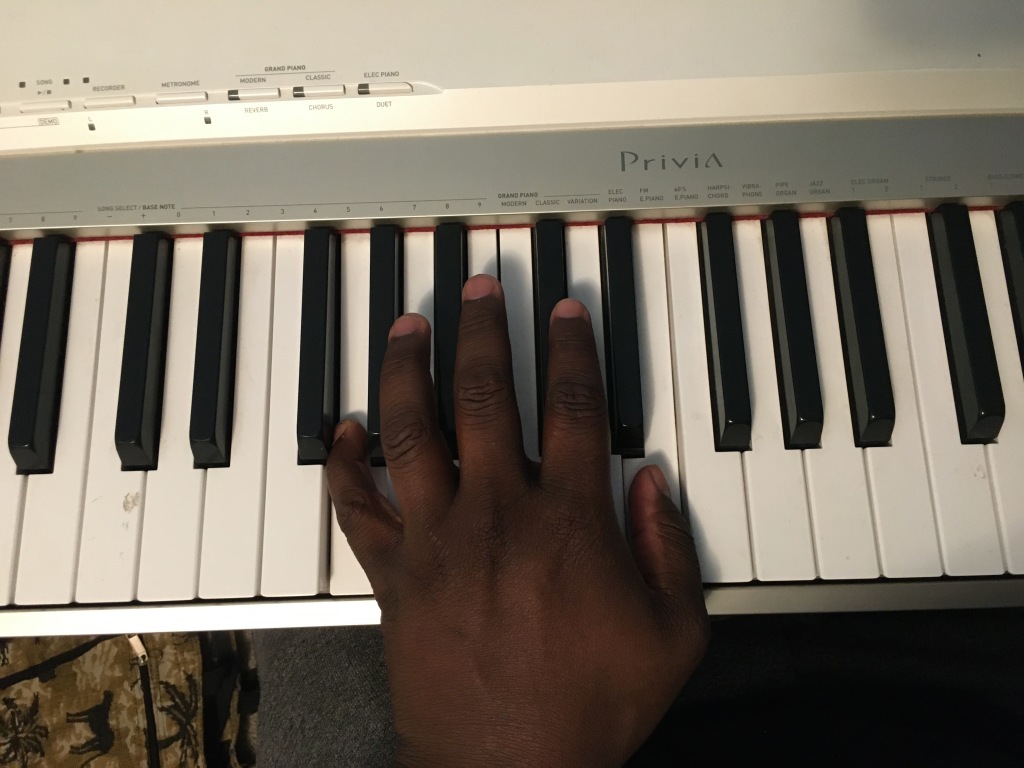UPDATE!
Say hello to my firstborn child:

She came in on Monday. I think her name is Vanesa.
CHORD OF THE WEEK
I wish I’d started doing this weeks ago. From now on, I will introduce you all to a new chord I have discovered and fallen in love with! To help with my training, I will use what I know about intervals, chords, and the circle of fifths to tell you exactly what the chord is called.
This week’s chord is called a major7/9. I love how melancholy and dense this chord sounds. Find a piano and play around with this chord when you get the chance!
The notes needed to play this chord are the 1, 2/9, 3, 5, and 7.
WHAT I LEARNED THIS WEEK
This week I learned about how to identify and build intervals, which are pairs of notes that start with the root note, and one other note in the scale.
MORE KEY WORDS
sharp, sharpen: to raise a note by a semi-tone, or up on key
flat, flatten:to lower a note by a semi-tone, or down a key
Here’s a picture of me playing a major seventh interval with a G note as the root note.

I found this interval by:
a) knowing which notes in the key of G were flat or sharp (via memorization of the circle of fifths), and…
b) knowing which note in the key of G was the seventh note in the major scale.
The next chord is a minor seventh interval, which requires that I flatten the seventh note in the G scale.

If I flatten this seventh note again, I end up with a diminished seventh interval…

…and if I sharpen theoriginal major seventh interval once, I get an augmented seventh interval.

ONLINE FLASHCARDS
So many terms and concepts to memorize!
No fear. I found online flashcards to be very helpful.
I used cram.com to make virtual flashcards that I can access on any device.
Last post I talked about the importance of both practical and theoretical learning. I see flashcards as a way for me to populate my mind with the necessary mechanical information. Drilling myself with these flashcards can then inform the way I understand what the heck I’m doing when I sit down at the piano and actually play.
WWW.TRELLO.COM
I also used this website called trello.com to help me map out my goals and ensure that I am making progress.
The website allows you to organize tasks into sections or “cards”. I have mine arranged as “things to do”, “doing”, and “done”. Under each card’s tasks, I can write down more detailed information about the task. Being able to move items from the “things to do” card to the “done” card helps me visualize my progress, and could also be useful to an educator who wants to keep their students on track.
OTHER REFLECTIONS
I found that when my piano teacher was trying to teach me these concepts over the video chat, there were communication break-downs due to the fact that I couldn’t see what she was playing on her keyboard, and she couldn’t see mine either.
I imagine that in future use of inline instruction, I would want to make sure that I have the necessary setup first. For example, it would be ideal if my teacher and I had over-head cameras, so she could see what I was doing.
After reflecting on this problem, I figured that in other disciplines, screencasting or screensharing could be useful, especially if the skill being learned by the student is on the computer. For example, a student learning video-editing online could share this screen with their instructor, making it easier for instruction, assessment, and feedback.

CONCLUSION
I am really happy with my progress. I know that in the past my mother has paid a lot of money to get me into drum lessons, and although there are benefits to in-person sessions, learning online is not only more affordable, but also very effective, considering all the tools you can find on the internet to track and enhance your learning.
this is really impressive! you’ve learnt a lot it seems like through this!
LikeLike